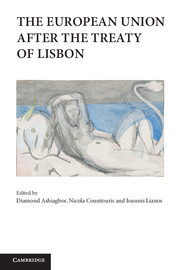Book contents
- Frontmatter
- Contents
- The European Union after the Treaty of Lisbon
- Introduction
- 1 The institutional development of the EU post-Lisbon
- 2 Competence after Lisbon
- 3 The Charter, the ECJ and national courts
- 4 Accession of the EU to the ECHR
- 5 EU citizenship after Lisbon
- 6 The law and politics of migration and asylum: The Lisbon Treaty and the EU
- 7 The European Union's common foreign and security policy after Lisbon
- 8 The European Ombudsman and good administration post-Lisbon
- 9 European contract law after Lisbon
- 10 Competition law in the European Union after the Treaty of Lisbon
- 11 The unexpected revision of the Lisbon Treaty and the establishment of a European stability mechanism
- Index
- References
Introduction
Published online by Cambridge University Press: 05 June 2012
- Frontmatter
- Contents
- The European Union after the Treaty of Lisbon
- Introduction
- 1 The institutional development of the EU post-Lisbon
- 2 Competence after Lisbon
- 3 The Charter, the ECJ and national courts
- 4 Accession of the EU to the ECHR
- 5 EU citizenship after Lisbon
- 6 The law and politics of migration and asylum: The Lisbon Treaty and the EU
- 7 The European Union's common foreign and security policy after Lisbon
- 8 The European Ombudsman and good administration post-Lisbon
- 9 European contract law after Lisbon
- 10 Competition law in the European Union after the Treaty of Lisbon
- 11 The unexpected revision of the Lisbon Treaty and the establishment of a European stability mechanism
- Index
- References
Summary
‘[O]nly by force can the gates of Lisbon be opened, and as for these inevitable disasters promised us, should they ever occur, that is something for the future, and to torment us with what has yet to come is nothing more than madness and a deliberate provocation of misfortune’
J. Saramago, The History of the Siege of Lisbon, 182Upon its signing in December 2007, the long-anticipated Treaty of Lisbon was ceremoniously heralded as ‘provid[ing] the Union with a stable and lasting institutional framework’ and as requiring ‘no change in the foreseeable future’. There was undoubtedly a pervasive sense of relief and accomplishment amongst European leaders. The then–Portuguese Prime Minister Mr José Sócrates stated that ‘what we are doing here is already part of History. History will remember this day as a day when new paths of hope were opened to the European ideal’. European Commission President José Barroso was perhaps more cautious, but his speech on ‘The European Union After the Lisbon Treaty’ revealed a considerable degree of satisfaction with what had been achieved in Lisbon, which he summarised as ‘improv[ing] the Union's capacity to pursue one of its central tasks: to shape globalization’. This was surely a far cry from the overly optimistic comments made by Mr Giscard d’Estaing, who in 2002 had famously predicted that the EU Constitution would have served Europe ‘for at least 50 years’, but enough to remind ourselves that the adoption of the Lisbon Treaty was celebrate with more fanfare than fado. Fado here refers to the rather sober, possibly sad Portuguese folk music. We would avoid any translation, certainly any literary one.
- Type
- Chapter
- Information
- The European Union after the Treaty of Lisbon , pp. 1 - 6Publisher: Cambridge University PressPrint publication year: 2012

